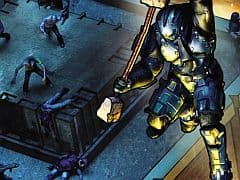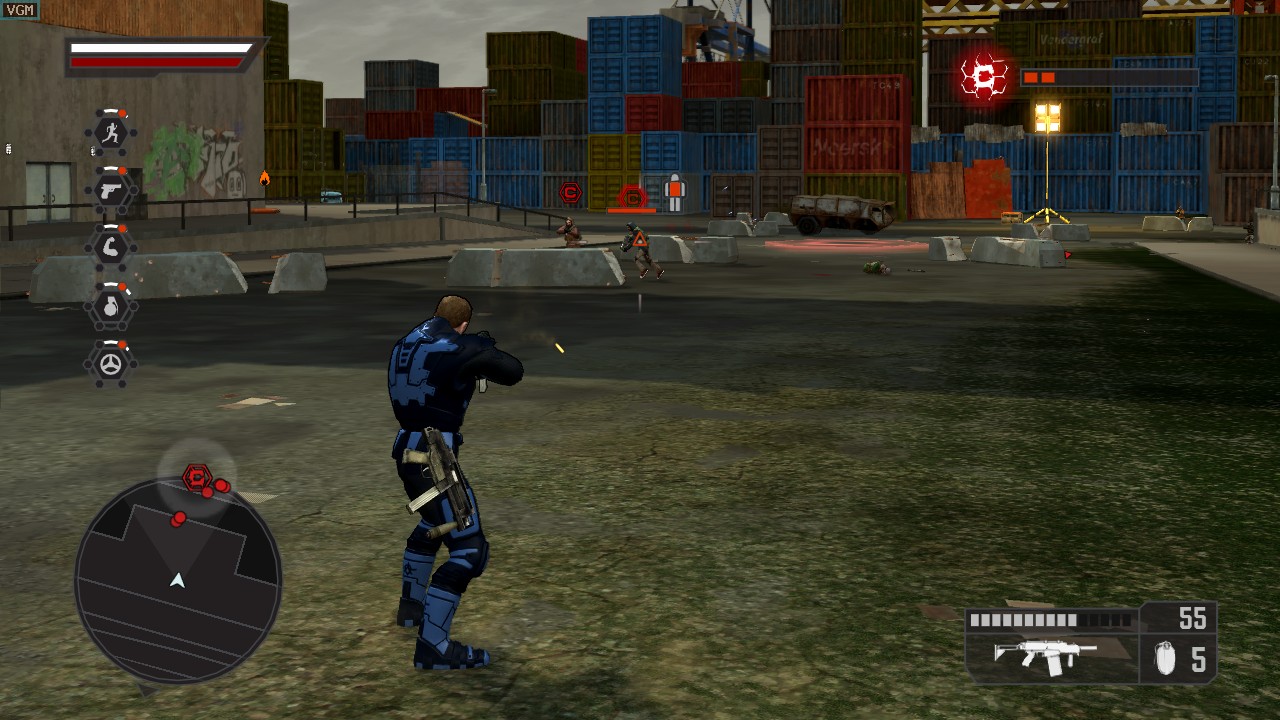You can trust VideoGamer. Our team of gaming experts spend hours testing and reviewing the latest games, to ensure you're reading the most comprehensive guide possible. Rest assured, all imagery and advice is unique and original. Check out how we test and review games here
After spending a few glorious hours hunting down agility orbs, mowing down Freaks in a super car, and generally blowing the crap out of stuff in Pacific city, we got to sit down for a conversation with James Cope, producer at Ruffian Games. Chatting about the sequel, James spoke about the challenges of co-operative game design, upcoming DLC, and what it’s like to take on a high profile series started by another developer.
Q: For those that missed out on the original, explain the concept of Crackdown and what its sequel brings to the sandbox genre?
James Cope: Crackdown 2 is an open world game, but we think of it as a really intense, over-the-top open world game where everything is very much action orientated. It’s about having lots of fun, becoming a super hero, jumping over buildings and blowing lots of stuff up. Shooting lots of enemies, there’s literally thousands of things on screen you can blow up, run over in a car, and we don’t really take it too seriously. We want that kind of intense video game action experience.
Some of the new things we’re bringing into all that is, you know, we wanted you to able to experience that open world experience, but with your friends – so with four-player co-op and sixteen-player multiplayer – it gives you all of those different ways of playing the game, and having that free form experience, but as a social thing as well.
Q: OK, so with the four player co-op – have you had to change the campaign drastically to support it?
JC: Yeah, I mean we’ve had to think very carefully about what missions work, cop-op and things like that. One of the beauties of Crackdown is that you could approach a mission area from any direction. That was something that was still unique to us. We needed to make sure everything we do in the game was achievable from one player’s perspective and achievable from a four-player perspective. So, we don’t actually make any decisions for the player, the player always gets to choose; do they want to do this on their own or do they want to do this with their friends? We make things compatible for that. It’s a really hard challenge from a design perspective, but it gives us that sense of everybody working towards an overall common objective to beat the game. But, doing it either together, or differently, so they all work together ultimately, but it’s however they want to choose to do that.
Q: So is the difficulty adjustable based on how many people are playing?
JC: Players get to choose that, they can make it more difficult, or they can make it easier. One of things we believe with co-op, and especially the type of game here, is that you can bring in other people to make it easier if you’re having trouble. So, there’s different ways of approaching it. Again, it’s we don’t make the decisions, you do.
Q: Zombies are one of the most over-used character/enemy designs in gaming today – what do they offer the narrative of Crackdown 2 that any other enemy couldn’t?
JC: Well it’s something we had to look at anyway. The freaks were in Crackdown, so we had to carry on with that arc. One of our desires from Crackdown 1 to Crackdown 2, was that in Crackdown we have this great civilian life; there was thousands of people wandering around the city, but every time you interacted with them in some way you were punished .You had your skills taken away from you if you tried to kill them, and we thought that was a really great gameplay mechanic that we were slapping people for every time they interacted with it. With Freaks it was a way of having thousands of enemies on screen at once, and still being able to have that satisfying reward of dealing with them, dispensing of them. So rather than punishing the player, we’re encouraging them to have thousands of enemies, and really that was the video game experience we were after. It was arcadey, and we really liked that.
Q: From my time with the game I’ve seen you’re right — there are a lot of enemies on screen at once. Have the graphics suffered much because of that? How have you managed to keep things looking as good as you have?
JC: Because we’ve got people who are a lot cleverer than me doing the work! It’s hard, very hard, to do with the network, and co-op and all that kind of stuff. But we’ve got some very clever people doing some very clever things, and they’ve made something that looked very impressive, and it’s thanks to them and their hard work. I wouldn’t even know where to begin in explaining that, but the team have worked very hard to make that vision a reality.
Q: An environment like Pacific City is perfect for in-game advertising – is this something that was discussed for Crackdown 2? How do you feel about adverts in games in general.
JC: I’m actually quite positive about it; I think it makes games look more grounded in the real world. The problem we’ve got with Crackdown is that it’s more of a hyper real world, and we want to be careful about how we present advertising in that because we were keen to maintain a graphic novel aesthetic, and people were very protective of their brand identities, especially in advertising. We don’t think those things necessarily match up together. We’ve got a very graphic novel style, we’d want to be able to have advertising in the game that is graphic novel in style, but that means more work in terms of developing those partnerships with advertisers and being able to change those identities to match the game. It’s very compelling for me because, like I say, it does make the game more grounded in the real world, but there are lots of technical and legal issues around being able to do that. It’s all about creative control in the end, and to be honest, you don’t want to make more problems for yourself, you want to make things easier.
Q: There are other sandbox games right now that are equally as ambitious in their scope – how do you feel about games such as Just Cause 2? Is there anything from games such as this you would have liked to integrate into Crackdown 2?
JC: I’ll be very straightforward and honest and say I haven’t had a chance to play Just Cause 2 yet, purely because of how hard we’ve had to work on Crackdown 2 over the last few months. I have looked at things like Prototype and Infamous, and they’ve taught us a lot. They looked at Crackdown obviously and thought ‘Wow, these things are cool’, and we’ve looked at them back and said ‘OK, some of that is good’, and other aspects we’ve thought, ‘well, that’s just reinforced the fact we knew we were onto something great’. Like the skill mechanic in Crackdown, which is something that’s unique to Crackdown’s world, it works really well in the Crackdown universe, but not so well in other games. I do think we’ve got something special that we can still borrow from people and trade off each other in terms of development of game overall. We do look at contemporary things and say ‘that works, that doesn’t’ and it’s great that we have that kind of flattering response from people.
Q: With regards to the campaign itself, how’s the mission structure changed? The first game was all about killing gang leaders, that’s essentially all you did. Has this changed much in the sequel? Is there more variation?
JC: There’s more variation, yeah. It was a criticism of Crackdown, and it’s a fair one to say, that the boss fights were all unrewarding and anticlimactic, and it’s purely because they were human characters exactly the same as other enemies except with a bigger health bar. There was no satisfaction to it. We wanted to fix that, so what we felt was better – and the approach we’ve taken now – is to have an overriding primary objective, that works through the entire game, rather than doing the same things 21 times, you’re actually doing parts of a puzzle that all connect together as a part of a complete mission structure.
So Project Sunburst is that; you’ve got different elements through it; you’re fighting against the cell, you’re connecting these webs of energy across the world, you’re destroying Freak lairs – all towards this ultimate objective. And that gives us a way of having a more jigsaw orientated approach to the overall game. So you’re connecting all this stuff together towards this ultimate thing at the end of the game, and it’s more climatic, and felt more compelled to work towards it, rather than just doing kill the boss, kill the boss, kill the boss.
Q: As I was playing the game, I saw an Xbox LIVE style orb – I presume that was for Time Trials?
JC: No, they’re LIVE orbs; they’re orbs you can collect in co-op.
Q: OK, so have Time Trials returned this time around?
JC: We’ve not got time trials in this time; we’ve got time trials for the entire game, but we don’t have boss time trials we had before, because we don’t have bosses. But you can speed-run the entire game and be rated against that. So that’s what people end up doing; resetting the game, playing again with all their skills and things.
LIVE orbs are interesting because whenever you find one you can stand over it and press B to invite a friend in, and start the game from that point on. They’re kind of like sign posts for bits of gameplay that would be good for co-op.
Q: Have you got any ideas for DLC yet? Keys to the city, or anything similar?
JC: Keys to the City will be back. I can’t go into feature detail on DLC yet, but people can expect to have new weapons, new vehicles, things like that. Same as before. But what we want to do most of all, and what we think we succeeded with last time, was the fact we created completely new game modes, and changed the way the game played through DLC – and we’ll be doing that again. So they can expect to radically change the way they play Crackdown 2 with DLC.
Q: Last question then. How does it feel to pick up a franchise started by another developer? Have you had much correspondence with Realtime Worlds and how they might have handled the sequel?
JC: We stay in good contact, we haven’t spoken in specific about Crackdown – they’re doing APB, we’re doing this – but we do wish each other well, we are very close, and some of our guys actually live together, they share houses and stuff like that. So, we’re not kidding when we say we are quite close. I hope that they continue to do well with APB, and I think they’d probably say we’ve done well with Crackdown. And for me, I think it’s good for players; they’ve got two games out of the position when they could have only had one.
Q: Thanks very much for your time.
JC: You’re welcome.
Crackdown 2 is out for Xbox 360 on July 9.

/https://oimg.videogamer.com/images/b604/crackdown_2_29.jpg)
/https://oimg.videogamer.com/images/9887/crackdown_2_28.jpg)
/https://oimg.videogamer.com/images/a2d7/crackdown_2_25.jpg)
/https://oimg.videogamer.com/images/62f9/crackdown_2_21.jpg)






